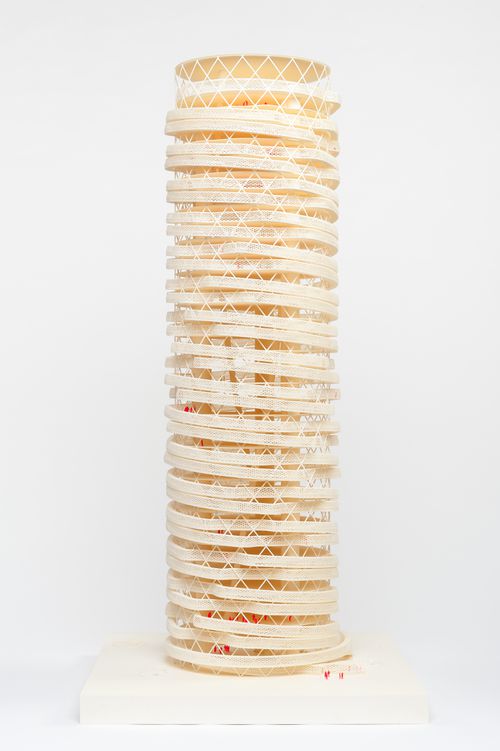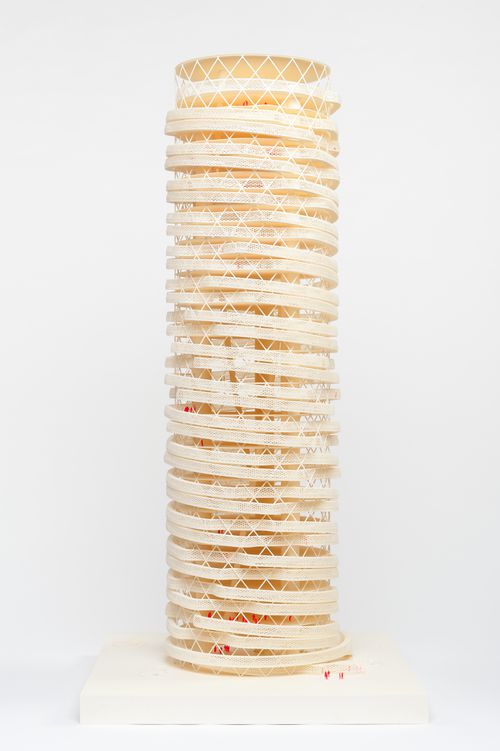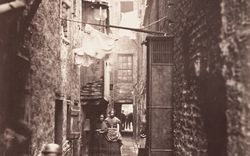Projet
Carbon Tower (2001)
AP174.S1.2001.D1
Description:
This project file documents an unbuilt design by Testa & Weiser for Carbon Tower (2001), a forty-storey building made almost entirely of carbon fibre. The project was developed in parallel with scripting software designed while Peter Testa and Devyn Weiser co-directed the Emergent Design Group at MIT. "The tower consists of an interdependent set of parts: floor plates hang from a diagrid structure of bundled fibres reinforced by two double-helix covered ramps, which are run in and out of the structure and are themselves made of strands woven at a finer scale. A thin composite skin—glass would be too heavy—wraps the tower’s parts together. A collaboration with Arup in 2002 allowed Testa & Weiser to simplify the scheme even further, by moving all core elements, from elevators to structural supports, to the tower’s perimeter. To take full advantage of the flexibility and energy efficiency of composite materials, Testa & Weiser also imagined that the carbon fibre structures would be formed on site through a process called pultrusion."[1] The file contains a large number of digital files documenting the conceptual and design development of the project; consultation with Arup Consulting Engineers, New York; research on composite materials; fabrication of 3D printed physical models by 3D Systems and Windform; and exhibition of the project at several museums and galleries, including the Museum of Contemporary Art, Los Angeles and the Cooper-Hewitt Smithsonian Design Museum, New York. Also contained in the file are 56 paper drawings (including some sketches done on top of printed computer-aided designs) and two 3D printed physical models produced by 3D Systems. Sources: [1] Canadian Centre for Architecture. Archaeology of the Digital 12: Testa & Weiser, Carbon Tower, ed. Greg Lynn (2015), ISBN 978-1-927071-25-0.
2002-2014
Carbon Tower (2001)
Actions:
AP174.S1.2001.D1
Description:
This project file documents an unbuilt design by Testa & Weiser for Carbon Tower (2001), a forty-storey building made almost entirely of carbon fibre. The project was developed in parallel with scripting software designed while Peter Testa and Devyn Weiser co-directed the Emergent Design Group at MIT. "The tower consists of an interdependent set of parts: floor plates hang from a diagrid structure of bundled fibres reinforced by two double-helix covered ramps, which are run in and out of the structure and are themselves made of strands woven at a finer scale. A thin composite skin—glass would be too heavy—wraps the tower’s parts together. A collaboration with Arup in 2002 allowed Testa & Weiser to simplify the scheme even further, by moving all core elements, from elevators to structural supports, to the tower’s perimeter. To take full advantage of the flexibility and energy efficiency of composite materials, Testa & Weiser also imagined that the carbon fibre structures would be formed on site through a process called pultrusion."[1] The file contains a large number of digital files documenting the conceptual and design development of the project; consultation with Arup Consulting Engineers, New York; research on composite materials; fabrication of 3D printed physical models by 3D Systems and Windform; and exhibition of the project at several museums and galleries, including the Museum of Contemporary Art, Los Angeles and the Cooper-Hewitt Smithsonian Design Museum, New York. Also contained in the file are 56 paper drawings (including some sketches done on top of printed computer-aided designs) and two 3D printed physical models produced by 3D Systems. Sources: [1] Canadian Centre for Architecture. Archaeology of the Digital 12: Testa & Weiser, Carbon Tower, ed. Greg Lynn (2015), ISBN 978-1-927071-25-0.
Project
2002-2014
Carbon Tower overall model
ARCH286150
Description:
3D printed 1:125 scale metric model produced by 3D Systems in Valencia, California using selective laser sintering (SLS) and stereolithography (SLA). The model is in several pieces. Assembly instructions can be found in the "EXTREME TEXTILES ASSEMBLY GUIDES" folder contained within group AP174.S1.2001.D1.006 ("Working files and correspondence related to 3D printed models").
2005
Carbon Tower overall model
Actions:
ARCH286150
Description:
3D printed 1:125 scale metric model produced by 3D Systems in Valencia, California using selective laser sintering (SLS) and stereolithography (SLA). The model is in several pieces. Assembly instructions can be found in the "EXTREME TEXTILES ASSEMBLY GUIDES" folder contained within group AP174.S1.2001.D1.006 ("Working files and correspondence related to 3D printed models").
Carbon Tower overall model
AP174.S1.2001.D1.019
Description:
3D printed 1:125 scale metric model produced by 3D Systems in Valencia, California using selective laser sintering (SLS) and stereolithography (SLA). The model is in several pieces. Assembly instructions can be found in the "EXTREME TEXTILES ASSEMBLY GUIDES" folder contained within group AP174.S1.2001.D1.006 ("Working files and correspondence related to 3D printed models").
2005
Carbon Tower overall model
Actions:
AP174.S1.2001.D1.019
Description:
3D printed 1:125 scale metric model produced by 3D Systems in Valencia, California using selective laser sintering (SLS) and stereolithography (SLA). The model is in several pieces. Assembly instructions can be found in the "EXTREME TEXTILES ASSEMBLY GUIDES" folder contained within group AP174.S1.2001.D1.006 ("Working files and correspondence related to 3D printed models").
maquettes
Carbon Tower section model
ARCH286149
Description:
3D printed 1:50 scale metric model produced by 3D Systems in Valencia, California using selecting laser sintering (SLS). The model is in several pieces. Assembly instructions can be found in the "EXTREME TEXTILES ASSEMBLY GUIDES" folder contained within group AP174.S1.2001.D1.006 ("Working files and correspondence related to 3D printed models").
2005
Carbon Tower section model
Actions:
ARCH286149
Description:
3D printed 1:50 scale metric model produced by 3D Systems in Valencia, California using selecting laser sintering (SLS). The model is in several pieces. Assembly instructions can be found in the "EXTREME TEXTILES ASSEMBLY GUIDES" folder contained within group AP174.S1.2001.D1.006 ("Working files and correspondence related to 3D printed models").
maquettes
2005
maquettes
Carbon Tower section model
AP174.S1.2001.D1.020
Description:
3D printed 1:50 scale metric model produced by 3D Systems in Valencia, California using selecting laser sintering (SLS). The model is in several pieces. Assembly instructions can be found in the "EXTREME TEXTILES ASSEMBLY GUIDES" folder contained within group AP174.S1.2001.D1.006 ("Working files and correspondence related to 3D printed models").
2005
Carbon Tower section model
Actions:
AP174.S1.2001.D1.020
Description:
3D printed 1:50 scale metric model produced by 3D Systems in Valencia, California using selecting laser sintering (SLS). The model is in several pieces. Assembly instructions can be found in the "EXTREME TEXTILES ASSEMBLY GUIDES" folder contained within group AP174.S1.2001.D1.006 ("Working files and correspondence related to 3D printed models").
maquettes
2005
né numérique
Quantité:
284 digital file(s)
AP174.S1.2001.D1.006
Description:
Contains STL and Rhinoceros files used to create the 3D printed models of Carbon Tower printed by 3D Systems, as well as related correspondence, information, model assembly guides, and agreements with vendors. Also included are photographs of a carbon fiber 3D printed model printed by Windform in Italy and STL files used in the production of the Windform model. Original directory name: "3D PRINTS". Most common file formats: STL (Standard Tessellation Language) Binary, 3DM, DS_store file (MAC), AutoCAD Drawing, JPEG File Interchange Format
2004-2006
Working files and correspondence relating to 3D printed models
Actions:
AP174.S1.2001.D1.006
Description:
Contains STL and Rhinoceros files used to create the 3D printed models of Carbon Tower printed by 3D Systems, as well as related correspondence, information, model assembly guides, and agreements with vendors. Also included are photographs of a carbon fiber 3D printed model printed by Windform in Italy and STL files used in the production of the Windform model. Original directory name: "3D PRINTS". Most common file formats: STL (Standard Tessellation Language) Binary, 3DM, DS_store file (MAC), AutoCAD Drawing, JPEG File Interchange Format
né numérique
Quantité:
284 digital file(s)
2004-2006
archives
Niveau de description archivistique:
Fonds
AP174
Résumé:
The Testa & Weiser project records, 2001-2014, document the firm’s involvement in several projects as well as the development and use of the software script Weaver. The bulk of the records in the archive are digital files, the majority of which relate to the unbuilt research projects Carbon Tower (2001) and Strand Tower (2006). The archive also contains eight 3D printed physical models and 56 drawings.
2001-2014
Documents d'archives des projects de Testa & Weiser
Actions:
AP174
Résumé:
The Testa & Weiser project records, 2001-2014, document the firm’s involvement in several projects as well as the development and use of the software script Weaver. The bulk of the records in the archive are digital files, the majority of which relate to the unbuilt research projects Carbon Tower (2001) and Strand Tower (2006). The archive also contains eight 3D printed physical models and 56 drawings.
archives
Niveau de description archivistique:
Fonds
2001-2014
Série(s)
AP174.S1
Description:
This series contains records relating to four projects by Testa & Weiser: Kings Road Apparel Shop (1999), Carbon Tower (2001), Filament Tower (2006), and Strand Tower (2006). The bulk of the records in the series are digital files, the majority of which relate to the unbuilt research projects Carbon Tower (2001) and Strand Tower (2006). These files include files relating to the conceptual design and design development of the projects, production of presentation materials and 3D printed physical models, and exhibition of the projects in museums and galleries. For the Kings Road Apparel Shop and Filament Tower projects, the Testa & Weiser records contain only a single digital folio each. In addition to the digital files, this series contains eight 3D printed models of Carbon Tower and Strand Tower and 56 paper drawings of Carbon Tower.
2002-2014
Projects
Actions:
AP174.S1
Description:
This series contains records relating to four projects by Testa & Weiser: Kings Road Apparel Shop (1999), Carbon Tower (2001), Filament Tower (2006), and Strand Tower (2006). The bulk of the records in the series are digital files, the majority of which relate to the unbuilt research projects Carbon Tower (2001) and Strand Tower (2006). These files include files relating to the conceptual design and design development of the projects, production of presentation materials and 3D printed physical models, and exhibition of the projects in museums and galleries. For the Kings Road Apparel Shop and Filament Tower projects, the Testa & Weiser records contain only a single digital folio each. In addition to the digital files, this series contains eight 3D printed models of Carbon Tower and Strand Tower and 56 paper drawings of Carbon Tower.
Series
2002-2014
Projet
AP174.S1.2006.D2
Description:
This project file documents unbuilt designs by Testa & Weiser for Strand Tower (2006), a continuation of the Carbon Tower research project. Various iterations of Strand Tower are woven out of carbon fibre according to a pattern algorithmically generated by the Weaver software. “The complexity of the final design is produced by arraying a basic fiber bundle of 114 strands; stacked 70 times for a total of approximately 8,000 strands.”[1] The file contains a large number of digital files which document the conceptual and design development of the project, fabrication of 3D printed physical models, and exhibition of the project at several museums and galleries, including the Museum of Contemporary Art, Los Angeles. The file also includes six physical models produced by the 3D printing firm 3D Systems. Sources: [1] "Strand Tower project and credit text" (AP174.S1.2006.D2.007). Testa & Weiser records, Centre Canadien d’Architecture/Canadian Centre for Architecture.
2006-2014
Strand Tower (2006)
Actions:
AP174.S1.2006.D2
Description:
This project file documents unbuilt designs by Testa & Weiser for Strand Tower (2006), a continuation of the Carbon Tower research project. Various iterations of Strand Tower are woven out of carbon fibre according to a pattern algorithmically generated by the Weaver software. “The complexity of the final design is produced by arraying a basic fiber bundle of 114 strands; stacked 70 times for a total of approximately 8,000 strands.”[1] The file contains a large number of digital files which document the conceptual and design development of the project, fabrication of 3D printed physical models, and exhibition of the project at several museums and galleries, including the Museum of Contemporary Art, Los Angeles. The file also includes six physical models produced by the 3D printing firm 3D Systems. Sources: [1] "Strand Tower project and credit text" (AP174.S1.2006.D2.007). Testa & Weiser records, Centre Canadien d’Architecture/Canadian Centre for Architecture.
Project
2006-2014
articles
Glasgow Improvements Act
19th century, albumen silver print, carbon print, Écosse, épreuve argentique à l'albumine, épreuve au charbon, Glasgow, Glasgow City Improvement Trust, health, photoengraving, photographie, photography, photogravure, santé, Scotland, slum, taudis, Thomas Annan, XIXe siècle
17 novembre 2011


